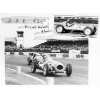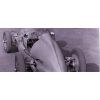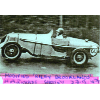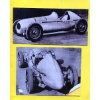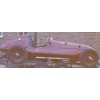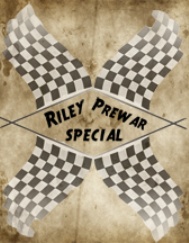

H.A.R. Formula 2
| Bezeichnung/description | H.A.R. Formula 2 Special |
| Jahrgang/year | 1949 |
| Kennzeichen/registration | not registered |
| Chassis-Basis/chassis base | Horace A. Richards design, all chrome-molybdenum. 2 parallel steel-tubes, with lateral X-members. Weight: 37.5kgs |
| Chassisnummer/chassisnumber | 1 |
| Chassisjahrgang/year chassis | 1949 |
| Motortyp/engine typ | Riley 6-cylinder 2-litre racing |
| Motornummer/engine number |
n/a
|
| Motorjahrgang/year engine | n/a |
| Bodyhersteller/bodymanufacturer | n/a |
| Rennhistory/racing history | to be advised |
| Information |
Independent suspension front and rear by alloy-wishbones
and adjustable torsion bars inside the chassis main-tubes. Rack and pinion steering. Magnesium alloy brake-drums. HAR alloy differential-casing, Riley internals with stepped-down horizontal spur-gearing on differential-nose to lower transmission line and seat-height. Riley c/r gearbox. The first of five chassis-frames made - other engines used inculde E.R.A. and Bugatti 3300cc HORACE RICHARDS AND THE H.A.R. - SOME NOTES Many members will remember the electrifying performances put up by a very fast Brooklands in the hands of Peter Binns and (before Peter had the car) when it was driven by Austen Nurse. 'What one tends to forget, however, is that (earlier still) the car had been breathed on by Horace Richards who had himself competed with it-not without success. Horace ran a garage in Birmingham, and devoted a considerable amount of time and energy to various aspects of motor sport. In 1952—spurred on, no doubt, by his campaign with the Brooklands—he produced an entirely new car for the then " Formula 2" calling it by his initials—"H.A.R." In the 'Racing Car Pocket Book' Denis Jenkinson wrote: "Horace Richards built his own tubular chassis, with independent suspension to all four wheels, and installed the 2 litre Riley engine for 1952/3 Formula 2 racing. A nicely made:, and well proportioned car ..." The opinion expressed in the last sentence is heartily endorsed by the Editor who can remember Horace performing with the car at Goodwood. In March, 1952, The Autocar featured this car in its series "Interesting Competition Cars," and in their article they gave technical details as follows. " The frame is a welded tubular structure consisting of two perfectly straight chrome molybdenum steel tubes, 3in. in diameter and 17-gauge, lying parallel with their centre's about 2ft. apart, and braced laterally by three main cross members. These are tubes of the same diameter as the longitudinals, strategically placed to take care of the torsional loads imposed by the front and rear suspension. The centre one is bowed slightly downwards and supports the rear of the power unit. In addition there are two two-inch cross tubes, one each at the extreme ends to carry the radiator block and tail fuel tank. Sheet metal box section pedestals are built up on each side at front and rear to provide a mounting point for the upper suspension arms, the same method being used for the forward engine bearers, which are designed to accommodate three alternative engine units. The frame weighs only 801b. Independent suspension at both front and rear is through unequal length wishbones controlled by Salter laminated-blade torsion bars. Levers on the ends of these are connected by links to levers of the same length formed integrally with the light alloy lower wishbones, which pivot on their own bearings on the frame. The torsion bars lie inside the main frame tubes and the abutment at their fixed ends is adjustable for trimming the level of the car. Girling piston-type dampers form the pivot point of the shorter upper wishbones. This much of the system is common to each wheel, the outer ends of the wishbones at the front being connected by forgings, machined all over and polished, which carry separate kingpins upon which pivot standard Riley stub axles. Riley rear hubs are bolted to light alloy carriers whose central bosses house additional bearings for the short axle shafts. Modified Girling hydraulic brakes having magnesium alloy shoes carried on similar back plates operate in centrifugally cast iron liners in magnesium alloy drums, the hand brake being mechanically operated and separate from the hydraulic system. The tunnel of the rack and pinion steering gear is mounted on brackets welded to the front main cross tube, and the column has two rubber-enclosed universal joints which give clearance for any of the three available engines. The ratio gives 2;I: turns from lock to lock. Universally jointed half-shafts transmit the drive to each rear wheel from a plain differential housed in an Elektron casing having integrally cast transverse arms which bolt on to faces welded to the frame tubes. On the front of the Elektron nosepiece a separate housing contains a pair of spur gears disposed one above the other so that the transmission line and seat level are lowered considerably. By transposing various gears in this housing, six different final drive ratios are available. Between this assembly and the tail of the gear box is a short universally jointed propeller shaft running in a sheet metal tunnel, the mountings for which, to guard against trouble in the event of failure of the shaft completely encircle both ends. In order to upset as little as possible the weight distribution of the car, which is approximately 50-50, the total fuel stowage is carried in three welded light alloy tanks, 17 gallons in the tail and 71 gallons in each wing tank on either side of the driving seat. An entirely separate feed allows fuel to be used first from the tail tank. Each tank has its light alloy quick-action filler cap and blow-off valves set to 21 lb. A hand operated pump supplies the pressure. Made of Duralumin in two main portions, scuttle and tail, the body has extremely pleasing contours formed over its steel tube frame, and is readily demountable from the chassis. The hoops of the framework terminate in small feet which bolt on to light sheet brackets welded to the chassis tubes. Louvered fairings flank the one-piece bonnet panel, which is secured by stout spring-loaded straps recessed to lie flush with the surface. A nose cowling and a full-length undertray complete the body parts, though additional fairing are contemplated over those parts of the suspension left exposed at present. A fixed screen of Perspex is flanked by twin rear view mirrors. Instruments are reduced to a rev counter, oil and air pressure and oil and water temperature gauges. Centre-lock wheels are shod with 5.00-17in. tyres at the front and 5.25- 18in. rear; the track is 4ft. 2in. and wheelbase 8ft. With 1,100 c.c. engine the weight is about 81 cwt." Sometime after the death of Horace Richards the Riley engined H.A.R.* was bought (but never raced) by Jack McEwen (of ex Lady Mary Grosvenor Sprite fame). Jack tells us that he obtained the car from a Mr. Bettinson who had bought it from A. L. Healey—the man who had taken over the Richards Garage. Bettinson had been fortunate in obtaining with the car one of the original 2 litre 6 cyl. Riley engines with E.R.A. crank and rods. Jack sold the car to Colin Clifford who did quite an amount of work on it, and turned it out in the same immaculate style as all his other cars. He brought it to a Coventry Rally a few years ago, and the sight and the sound of it were among the highlights of the day. Like others before him, however, Colin found that the car—although beautifully made—was not really competitive in the classes in which it was eligible. It has now passed out of his possession. It is worth mentioning, in conclusion, that there were rumors of a further H.A.R. under construction. This was, so we understand, a 'pipe- dream ' of a car with a ladder type chassis, independent suspension all round, and a 16 litre de Haviland Chipmunk' engine. Nothing whatever to do with Rileys, but interesting all the same. * There was a second H.A.R.. but although having a similar chassis it was fitted with a Jaguar engine, and is of little interest to the Riley Register. |

